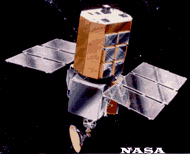SMM
Solar Maximum Mission
 The Solar Maximum Mission (SMM) was intended primarily to study solar flares and related phenomena. Launched during a period of maximum solar activity, SMM observed more than 12,000 flares and over 1,200 coronal mass ejections during its 10 year lifetime. SMM provided measurements of total solar radiative output, transistion region magnetic field strengths, storage and release of flare energy, particle accelerations, the formation of hot plasma, and coronal mass ejection. The payload also observed the short-wavelength and coronal manifestations of flares. Observations from SMM were coordinated with in situ measurements of flare particle emissions made by the ISEE 3 satellite. SMM was the first satellite to be retrieved, repaired and redeployed in orbit. In 1984, the STS-41C Shuttle crew restored the spacecraft's malfunctioning attitude control system and replaced a failed electronics box for the coronagraph/polarimeter. SMM
collected data until November 24, 1989, and re-entered on December 2, 1989.
The Solar Maximum Mission (SMM) was intended primarily to study solar flares and related phenomena. Launched during a period of maximum solar activity, SMM observed more than 12,000 flares and over 1,200 coronal mass ejections during its 10 year lifetime. SMM provided measurements of total solar radiative output, transistion region magnetic field strengths, storage and release of flare energy, particle accelerations, the formation of hot plasma, and coronal mass ejection. The payload also observed the short-wavelength and coronal manifestations of flares. Observations from SMM were coordinated with in situ measurements of flare particle emissions made by the ISEE 3 satellite. SMM was the first satellite to be retrieved, repaired and redeployed in orbit. In 1984, the STS-41C Shuttle crew restored the spacecraft's malfunctioning attitude control system and replaced a failed electronics box for the coronagraph/polarimeter. SMM
collected data until November 24, 1989, and re-entered on December 2, 1989.
Spacecraft
The solar payload instruments and the sun-sensor system were contained in the instrument module occupying the top 2.3 meters of the craft. The Multimission Modular Spacecraft (MMS), below the instrument module, contained the systems for attitude control, power, communication, and data handling. Two fixed solar panels, located between the instrument module and the MMS supplied 1500-3000W. The fine-pointing Sun-sensor system had a precision of 1 arcsec along all 3 axes.
Payload
Active Cavity Radiometer Irradiance Monitor (ACRIM) - measured total solar irradiance.
Gamma Ray Spectrometer (GRS) - studied the composition of solar and interstellar
gamma ray emissions.
Hard X-ray Burst Spectrometer (HXRBS) - studied hard X-ray spectra of solar flares in 15 energy channels between 20-260 keV.
soft X-ray Polychtomator (XRP) - monited soft X-ray emissions.
Hard X-ray Imaging Spectrometer (HXIS) -
Ultraviolet Spectrometer and Polarimeter (UVSP) - a raster imager providing
0.04 A sp. res.
Coronograph/Polarimeter - studied the faint solar corona between 2 and 5 solar radii
with a 6.4 arcsec resolution.
| Country of Origin | United States |
| Customer/User | NASA |
| Manufacturer(s) | Fairchild |
| Size | 4 meters long |
| Orbit | 512 km x 508 km; incl.= 28.5 deg |
| Related Sites | SMM at GSFC SMM Data |
Launch Facts
| Name | Int'l Desig. | Date | Site | Vehicle | Orbit | Mass(kg) |
| Notes | ||||||
| SMM | 1980-014A | 2/14/80 | ESMC | Delta 3910 | LEO | 2315 |
| Solar Maximum Mission; solar observatory; repaired 4/9/84 by STS-41C in orbit | ||||||
Information in The Mission and Spacecraft Library is provided without warranty or guarantee. USE AT YOUR OWN RISK.